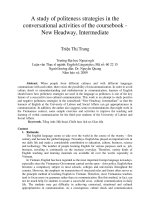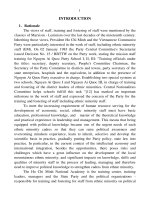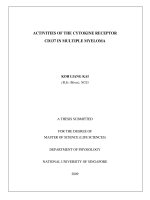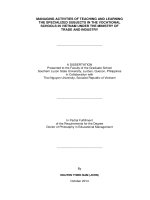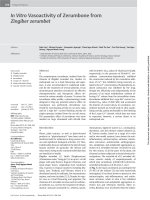Tyrosinase inhibitory activities of zerumbone in zingiber zerumbet smith and rutin in sophora japonica
Bạn đang xem bản rút gọn của tài liệu. Xem và tải ngay bản đầy đủ của tài liệu tại đây (1.29 MB, 65 trang )
VIETNAM NATIONAL UNIVERSITY OF AGRICULTURE
FACULTY OF BIOTECHNOLOGY
-------oOo-------
UNDERGRADUATE THESIS
TYROSINASE INHIBITORY ACTIVITIES OF
ZERUMBONE IN ZINGIBER ZERUMBET SMITH AND
RUTIN IN SOPHORA JAPONICA
HANOI, 02/2021
VIETNAM NATIONAL UNIVERSITY OF AGRICULTURE
FACULTY OF BIOTECHNOLOGY
-------oOo-------
UNDERGRADUATE THESIS
TYROSINASE INHIBITORY ACTIVITIES OF
ZERUMBONE IN ZINGIBER ZERUMBET SMITH AND
RUTIN IN SOPHORA JAPONICA
Student name
: Nguyen Thi Lan
Student code
: 610638
Department
: Biotechnology
Supervisor
: Phi Thi Cam Mien, MSc.
HANOI, 02/2021
COMMITMENT
I certainly assure that all results, images and research data were done by me,
have not been previuosly submitted by any other undergraduate education institution.
All the information quoted in the thesis which is traced to the science sources and any
help is appreciated.
I accept responsibility for my pledge to the Academy and the Council.
Hanoi, January 30th, 2021
Nguyen Thi Lan
i
ACKNOWLEDGEMENTS
After a period of working and researching, I have finally completed a graduation
thesis with the topic: “Tyrosinase inhibitory activities of ZER in Zingiber zerumbet
Smith and Rutin in Sophora japonica”.
This project was conducted at Institute of Research and Development of
Microalgae, Faculty of Agronomy in Vietnam National University of Agriculture
(VNUA) and Vietnam Academy of Science and Technology (VAST).
This graduation thesis is the last step to help me complete the training program
of VNUA within 4.5 years. To graduate on time is always the wish of me and other
Advanced Biotechnology students. VNUA not only gives students knowledge and
skills to enter the life, herely we are forged in the enivironment with many different
pressures. It is these pressures that make Biotechnology students stronger,
persistentand be able to endure. Together overcoming such difficulties that are all my
friends and relatives who have helped me in challenge time, I am very grateful to all of
them during the past school years. To be done this gradutation thesis, I have received
enthusiastic help from you at the Institute of Research and Development of
Microalage. I sincerely thank Phi Thi Cam Mien and Ha Viet Cuong for directing
guidance, enthusiastic guidance and giving motivation while I was doing experiments.
My deeply thanks come to all our friends during time we study in VNUA. Their
kindly help, care, motivation gave us strength and lift us up all the trouble for the rest
of our life.
Hanoi, January 30th, 2021
Student
Nguyen Thi Lan
ii
INDEX
COMMITMENT ..............................................................................................................i
ACKNOWLEDGEMENTS ........................................................................................... ii
INDEX ........................................................................................................................... iii
LIST OF TABLES ..........................................................................................................v
LIST OF FIGURES ....................................................................................................... vi
LIST OF ABBREVIATIONS ...................................................................................... vii
ABSTRACT ....................................................................................................................1
CHAPTER I. INTRODUCTION ....................................................................................2
1.1. Introduction ..............................................................................................................2
1.2. Objectives and requirements ....................................................................................3
1.2.1. Objectives .............................................................................................................3
1.2.2. Requirements .........................................................................................................3
CHAPTER 2: LITERATURE OVERVIEW ...................................................................4
2.1. Ginger- Zingiberaceae family and ZER in Z. zerumbet Smith introduction ...........4
2.1.1. Ginger- Zingiberaceae family introduction ..........................................................4
2.1.2. Zingiber zerumbet Smith introduction ..................................................................5
2.1.3. ZER overview ......................................................................................................10
2.2. Sophora japonica bud flowers and Rutin overview ...............................................14
2.2.1. Sophora japonica introduction ............................................................................14
2.2.2. Rutin overview ....................................................................................................15
2.4. The mechanism of melanin pigment production in skin color ...............................18
2.4.1. Enzyme tyrosinase overview ...............................................................................18
2.4.2. The mechanism of tyrosinase activity in skin color ............................................21
2.4.3. Tyrosinase inhibitor sources ................................................................................23
2.4. Enzyme kinetic .......................................................................................................26
2.5. Reseaches in tyrosinase inhibitory activities of Secondary natural products
in Vietnam and the world ..............................................................................................29
2.5.1. In Vietnam ...........................................................................................................29
2.5.2. In the world..........................................................................................................30
CHAPTER 3: MATERIALS AND METHODS ...........................................................31
3.1. Materials, reagents and equipments .......................................................................31
iii
3.1.1. Matreials ..............................................................................................................31
3.1.2. Reagents...............................................................................................................31
3.1.2. Equipments ..........................................................................................................31
3.1.3. Time and location ................................................................................................31
3.2. Contents ..................................................................................................................31
3.3. Methods ..................................................................................................................32
3.3.1. ZER isolation in the different sample states by Solvent extraction ....................32
3.3.2. Extracting of Rutin ..............................................................................................36
3.3. Reagent preparation ................................................................................................37
3.3.1 Potassium phosphate buffer 0,1M, pH = 6,8 ........................................................37
3.3.3. L-DOPA substrate ((3-(3,4-Dihydroxyphenyl)-L-alanine) .................................38
3.3.3. Arbutin disulting ..................................................................................................38
3.3.4. DMSO solvent (Dimethyl sulfoxide) ..................................................................39
3.3.5. Enzyme mushroom tyrosinase .............................................................................40
3.4. The ZER and Rutin extracting solution ..................................................................40
3.5. Tyrosinase inhibitory activities experiments from ZER and Rutin........................41
CHAPTER 4: RESULTS AND DISCUSSION ............................................................44
4.1. Results ....................................................................................................................44
4.1.1. The effect of different samplesin the productivity of ZER .................................44
4.1.2. The effect of the extracting solvents in the productivity of Rutin from
Sophora japonica bud flowers.......................................................................................45
4.1.3. Tyrosinase inhibitory activities of ZER and Rutin..............................................45
4.1.5. Enyme kinetics of ZER and Rutin inhibitors ......................................................48
4.2. Discussion...............................................................................................................49
CHAPTER 5. CONCLUSION ......................................................................................51
REFERENCES ..............................................................................................................52
iv
LIST OF TABLES
Table 2.1: Some species and distribution in Zingiberaceae family ................................4
Table 2.2: Chemical compounds in Zingiberaceae family[2].........................................5
Table 2.3: Characteristic features of zerumbone ...........................................................11
Table 2.4: Different species of plants and their parts used for isolation of Rutin.........16
Table 2.5: The physicochemical properties of Rutin ....................................................17
Table 3.1: The different concentrations of Arbutin .......................................................39
Table 3.6: The volume of components in each ELISA well .........................................42
Table 3.7: The volume of components in each ELISA well .........................................43
Table 4.1. The total of ZER isolated from fresh rhizomes, leaves and stems ...............44
Table 4.2: The different solvents efficiency in the productivity of Rutin .....................45
Table 4.3. The absorbtiontion of ZER inhibitor in anti-tyrosinase activity assay at
492nm ............................................................................................................................47
Table 4.4. The absorbtion of Rutin inhibitor in anti-tyrosinase activity assay at 492nm
.......................................................................................................................................47
Table 4.5: The percent of Tyrosianse inhibitory from ZER and Rutin .........................47
v
LIST OF FIGURES
Figure 2.1. (a) Zingiber zerumbet (L.) Roscoe ex Sm tree, (b) rhizome .........................6
Figure 2.2: The terpenes compounds isolating from the Z. zerumbet Smith ..................8
Figure 2.3: The polyphenols compounds isolating from Z. zerumbet Smith ..................9
Figure 2.4: The structure of Zerumbone........................................................................10
Figure 2.5: Saphora japonica bud flowers .....................................................................15
Figure 2.6: Rutin chemical structure .............................................................................15
Figure 2.7: Soxhlet apparatus ........................................................................................18
Figure 2.8: Structure of tyrosinase ................................................................................19
Figure 2.9: Production of different pigments by melanosomes ....................................22
Figure 2.10: Structure or melanosome distribution for different racil groups ..............23
Figure 2.11: The effects of substrate concentration on a reaction initial velocity ........28
Figure 2.12: Different types of enzyme inhibition show on a Lineweaver- Burk plot .29
Figure 3.1: Rhizome (a), stem (b) and leaves soaking (c) and n-hexan solvent (d) ......33
Figure 3.3: Column for the isolation of dichloromethane .............................................35
Figure 3.5: S. Japonica bud flowers extracting in ethyl acetate (a), ethanol 96o and pure
water (c) by Soxhlet apparatus ......................................................................................37
Figure 3.6: L-DOPA (3-(3,4-Dihydroxyphenyl)-L-alanine) .........................................38
Figure 3.7: Arbutin ........................................................................................................39
Figure 3.8: DMSO solvent (Dimethyl sulfoxide) ..........................................................39
Figure 3.9: Enzyme mushroom tyrosinase ....................................................................40
Figure 3.10: ELISA MR-96A Mindray Reader (96 wells) ...........................................41
Figure 4.1. ZER extract .................................................................................................44
Figure 4.2. The determination of tyrosinase concentrations .........................................46
Figure 4.3. The percent inhibition of tyrosinase activity from ZER and Rutin ............48
Figure 4.4. Linewear- Burk plot for tyrosinase enzyme inhibition of by ZER and Rutin (a),
(b). Tyrosinase inhibition was analyzed in the presence of different sample concentration as
follow 50, 400, 800 and 1000 µg/mL. The effect of ZER and Rutin in the presence of
different concentration of substrate L- DOPA 1, 2, 3, 5mM. .............................................49
vi
LIST OF ABBREVIATIONS
Zerumbone
: ZER
Ultraviolet
: UV
Reactive oxygen species : ROS
Lactic acid bacteria
: LAB
Substrate complex
: ES
AND
: Deoxyribonucleic acid
L-DOPA
: 3-(3,4-Dihydroxyphenyl)-L-alanine)
HQ
: Hydroquinone
DMSO
: Dimethylsulfoside
Km
: Michenlis Menten constant
IC50
: The percent of tyrosinase at 50%
vii
ABSTRACT
The aims of this study were to determine the ZER chemical structure, the ZER
productivity in different sample from Z. zerumbet Smith and the Rutin yied from S.
japonica bud flowers in different solvents, then develop the whitening cream from the
extract and finally evaluate the satisfaction by users. The results showed the Solvents
extraction technique has given the productivity of ZER in different samples rhizomes
(0.35%), leaves (0.1%) and stem (0.034%) in the fresh material.
In this review paper showed that the content of Rutin increased with the
increase of processing temperature, but if the processing time is too long Rutin content
will gradually decrease. Under certain processing conditions, different solvents also
have effected to the productivity of Rutin, then the Rutin content in water 3.3 %,
Ethanol 96° (23.8%) and Ethyl acetate (15.4%).
Following the calculation of tyrosinase inhibition percentage from ZER and
Rutin, the ZER and Rutin concentrations were lowest at 50 ug/mL, reaching 13.38%,
4.55%, when at the highest concentration 1000 ug/mL reaching 86.46% and 70.03%.
Futhermore, the ZER and Rutin extracts were examined for anti-tyrosinase
activity compared with Arbutin. IC50 of Arbutin was 100.80 µg/mL (217.8 mM)
whereas IC 50 of ZER and Rutin extract were 265.8 µg/mL and 512.7 µg/mL.
In addition, The Km values of ZER and Rutin were 1.843 mM and 2.195 mM,
for L-DOPA substrates and both are competitive inhibitos. ZER has been lower Km
that mean is greater than Rutin in tyrosinase inhibitory activities.
It can be concluded that ZER and Rutin extracts can be applied in cosmetic
industry to increase the value of ZER and Rutin wast.
1
CHAPTER I. INTRODUCTION
1.1. Introduction
Skin is an important component of body image and has immense physiological
importance for both women and men. Skin pigmentation can be a source of significant
emotional distress in individuals. Along human history, people have been struggling
with numerous skin diseases, especially skin pigmentation. It is well documented that
tyrosinase is an essential enzyme, which contributes towards pigment formation in
mammalian's body as well as in plants, microorganisms and fungi. Use of tyrosinase
inhibitors is becoming increasingly important in the cosmetic industry due to their skin
whitening effects. To approach this desire, many products have been already produced
and tested to overcome melanogenesis problems.
As known, melanin is the root cause for blackening of the skin. Its formation
beneath the skin proceeds through freeradical mechanism. UV radiations facilitate this
chain reaction and it could be disrupted by selective use of compounds, potent enough
to inhibit this reaction. Quinones are highly reactive compounds and can polymerize
spontaneously to form high molecular weight compounds or brown pigments
(eumelanin or pheomelanin). Melanin plays an important role in protecting human skin
from the harmful effects of ultraviolet (UV) radiations by absorbtioning UV sunlight,
removing reactive oxygen species (ROS) and scavenging toxic drugs and chemicals. A
number of skin lightening agents which are derived from natural resources particularly
plants, are already used in cosmetic products such as: Hydroquinone (isolated from
Cystoseria jabokae and C. adriatica), Azelaic acid (isolated from Pitirosporum ovale),
Kojic acid (fungal metabolic product) and Arbutin (a glycosylated hydroquinone found
in certain plants). Despite the extensive researches on lightening agents and
hyperpigmentation, the existing agents have got limitations in term of high toxicity,
low stability, poor skin-penetration, and insufficient activity. Tyrosinase inhibition is
the most common approach to achieve skin hypo-pigmentation as this enzyme
catalyses the rate-limiting step of pigmentation [1]. Therefore, in this study that
investigated the potential of a few plants for skin hypo-pigmentation. Undoubtedly,
2
South East Asia is one of the world's major sources of useful plant resources and due
to the rich plant diversity existing. A number of South East Asia plants are known to
have various phenolic and triterpenoid compounds such as catechin, chalcone,
flavones, quercetin, saponins etc. That were selected for the present study based on
their chemical constituents specially those which are known to be rich in the phenolic
and triterpenoid group of compounds. A linearis is used in various cosmetic products
ranging from shampoos, tonics, creams and skin care products. It is used frequently to
treat skin problems such as eczema, nappy rash and acne, so when applied topically it
has a soothing effect on the skin. Two compounds “Zerumbone” and “Rutin” which
are widely used as pharmaceuticals have been isolated from the rhizomes, stems and
leaves of Z. zerumbet Smith and the bud flowers of S. japonica. It is well known that
the natural compounds show good inhibition of tyrosinase activity. ZER and Rutin
extracts of selected plants were evaluated for their inhibitory effect on the
monophenolase and diphenolase activated forms of tyrosinase in vitro. It is very
encouraging to explore the potential of plants for cosmaceutical purposes.
1.2. Objectives and requirements
1.2.1. Objectives
The aims of this study were to determine anti-tyrosinase activities of ZER in Z.
zerumbet and Rutin in S. japonica extracts, then develop the whitening cream from the
extracts and finally evaluate the satisfaction by users.
1.2.2. Requirements
Study on the effect of sample state in the productivity of ZER from Z. zerumbet
rhizome, stem and leaves.
Dtermination of ZER chemical structure by by Solvent extraction using thin
layer chromatography.
Research the effect of the extraction solvents in the productivity of Rutin from
Sophora japonica bud flowers.
Evaluate tyrosinase inhibitory activities of ZER and Rutin as well as inbibitors.
3
CHAPTER 2: LITERATURE OVERVIEW
2.1. Ginger- Zingiberaceae family and ZER in Z. zerumbet Smith introduction
2.1.1. Ginger- Zingiberaceae family introduction
2.1.1.1. Characteristics features and distribution of Zingiberaceae family
The family Zingiberaceae are readily differentiated from other families in the
order. The pantropical Zingiberaceae is the largest family in the order Zingiberales
with 53 genera and over 1200 species. Zingiberales currently has within eight families
of which, the Zingiberaceae ginger family is one of the largest families and is
predominantly found in tropical Asia. That have been reported to be useful as food,
traditional medicine, spice, condiment, dye and flavour. These are perennial aromatic
herbs which form part of the undergrowth flora of tropical and subtropical forests with
orchid like flowers. More than 150 wild and cultivated Zingiberaceous species have
been reported for Peninsular Malaysia and 40-50 species have been widely utilized for
various purposes [2].
Table 2.1: Some species and distribution in Zingiberaceae family
No.
Species
Distribution
1
Zingiber aromaticum
Asia tropical forest, Indonesia
2
Zingiber cassumunar
Thailand, Malaysia
3
Zingiber clarkii
India
4
Zingiber corallinum
China
5
Zingiber gramineum
America
7
Zingiber montanum
India, Sri Lanka, Indonesia
8
Zingiber officinale
Japan, China, Vietnam, Taiwan…
9
Zingiber pachysiphon
Australia
10
Zingiber rubens
Indonesia, Malaysia
11
Zingiber spectabile
Malaysia
12
Zingiber zerumbet
South Asia, South east Asia
4
2.1.1.2. Chemical compounds
Other studies on species in the family Zingiberaceae have shown that the
chemical compounds are very diverse. Scientists around the world have researched and
isolated many active compounds from species in the family Zingiberaceae. Different
species contain compounds with different activities such as monoterpene,
sesquiterpene, phenylbutenoids, flavonoids.
Table 2.2: Chemical compounds in Zingiberaceae family [2]
No
Species
Chemical compounds
1
Zingiber cassumunar
α-caryophyllene
2
Zingiber corallinum
sesquiphellandrene, Sabinene
3
Zingiber montanum
terpinen-4-ol, Sabinene
4
Zingiber moran
camphene, citral, linalool
5
Zingiber nimmonii
β-caryophyllene, myrcene
6
Zingiber officinale
monoterpene và sesquiterpene
7
Zingiber wrayi
trans-anethole
8
Zingiber zerumbet
zerumbone, α-humulene
2.1.2. Zingiber zerumbet Smith introduction
2.1.2.1. Characteristic features and distribution of Z. zerumbet Simth
Zingiber zerumbet (L.) Smith tree, belonging to Zingiberaceae family, is an
edible ginger, originating in Southeast Asia and has been cultivated for thousands of
years as a spice and for medical purposes. The ginger is herbaceous species 1-1.3m
high, with sheaths. Rhizomes are tuberous, branched, the outer surface is white, the
inside is yellowish-yellow. The leaves are staggered, almost no stalk, oblong spear,
pointed, tapered at the base, dark green on, pale and scattered on the underside, the
sheath is smooth excepted at the tip. The flower staff is 30-60cm long, covered with
many roofing scales, with outer hair. Shaped egg with large, close-fitting leaves,
bird's-eye shape, green, 25-30mm in diameter. Yellow flower, corolla tube 2cm, with
spear-shaped lobes, lip wing has 3 lobes, larger middle lobe, concave, convex, integer
lobes, 3 times shorter. The fruit capsule has oval shape, black seeds, few seeds, white
seed coat [3].
5
(a)
(b)
Figure 2.1. (a) Zingiber zerumbet (L.) Roscoe ex Sm tree, (b) rhizome
2.1.2.2. Traditional use of ginger
This herbal plant is popularly referred to as the pinecone, wild ginger, Asian
ginger, or shampoo ginger. Generally, the rhizome and the leaves are used for spice,
tea, beverage, and medical purposes, while the milky, mucilaginous substance of the
inflorescences (pinecones).
Z. zerumbet, commonly known as the pineconeor shampoo ginger, is a
perennial, tuberous root herb plant that can be found growing naturally in damp,
shaded partsof the lowland or hill slopes, as scattered plants or thickets. It is known by
various names, for example, “Lempoyang” (Malaysia and Indonesia), “Ghatian” and
“Yaiimu” (India), “Jangli adha” (Bangladesh), “Awapuhi” (Hawaii), “Zurunbah”
(Arab), “Hong qiu jiang” (China), and “Haeo dam” or “Hiao dam” (Northern
Thailand). This herbal plant is believed to be native to India and the Malaysian
Peninsula, and since it has been cultivated for so long in so many places throughout
Southeast Asia, the Pacific, and Oceania, it became uncertain as to where the plant had
originated. Z. zerumbet has also been claimed to be introduced throughout the Pacific
by the ancient Polynesian settlers [4]. Some of the traditional usages of Zingiber
zerumbet as botanical medicine include the treatment of inflammation, fever,
toothache, indigestion, constipation, diarrhea, severe sprains, and to relieve pain, as
well as antispasmodic, antirheumatic, and diuretic agents.
6
2.1.2.3. Chemical compounds in Z. zerumbet Smith
In Z. zerumbet Smith, rhizome (tuber) is the most used part in medicine, it has
been determined that the rhizome (tubers) has many different active ingredients,
mainly terpenes and polyphenols.
2.1.2.3.1. The terpenes compounds isolating from the Z. zerumbet Smith
In 1960 Dev isolated ZER (9) from the essential oil of Zingiber zerumbet and
determined its structure.
In 1963 Nigam and Levi studied the compounds in Zingiber Zerumbet essential
oil obtained eight compounds ZER (9), borneol (10), α-pinene (11), camphor (12),
linalool (13), limonene (14), α-humulene (15), β-caryophyllene (16).
In 1968 Damodaran and Dev isolated humulene epoxide I (17), II (18) and III
(19), humulenol I (20), II (21), and caryophyllene oxide (22).
In 2013, Dai et al. identified more compounds camphene (23), sabinene (24),
citral (25), zingiberene (26), lavandulyl acetate (27).
In 2009, Rout et al. Performed quantitative analysis and further identification of
compounds α-caryophyllene, 3-carene (28), 4-terpineol (29), eucalyptol (30).
In 2010, Sulaiman et al. Isolated and quantified the compounds in essential oils
identified two more γ-terpinene (31), β-phellandrene (32).
In 2013, Batubara et al. Studied the essential oil composition of Zingiber
zerumbet and discovered a compound β-myrcene (33) [5;7].
7
O
OH
O
9
10
11
12
OH
H
13
14
15
O
H
16
17
OH
O
HO
O
18
19
20
21
O
CHO
H
H
22
23
24
25
O
O
H
H
26
27
28
O
H
OH
29
30
31
32
33
Figure 2.2: The terpenes compounds isolating from the Z. zerumbet Smith
8
2.1.2.3.3. The polyphenols compounds isolating from Z. zerumbet Smith
In 2008, Chien et al isolated the following flavonoids from the rhizome of
ginger: kaempferol-3-O- (2,4-di-O-acetyl-α-ʟ-rhamnopyranoside) (34), kaempferol-3 O- (3,4-di-O-acetyl-α-ʟ-rhamnopyranoside) (35).
In 2007, Ruslay et al. also isolated flavonoids: kaempferol-3-O-rhamnoside (36),
kaempferol-3-O- (4”-acetyl) rhamnoside (37).
In 2004, Jang et al. studied on aromatic compounds and flavonoids in Ginger Gio
tree isolated the following substances: kaempferol-3,4-O-dimethylether (38),
kaempferol-3-O-methylether (39), kaempferol-3,4,7-O-trimethylether (40), 4”-Oacetylafzelin (41), 2 ", 4" -O-diacetylafzelin (42), 3 ", 4" -O-diacetylafzelin (43) [8-9].
OH
HO
O
OR3
R 1O
O
OH
O
O
O
OR1
OR2
OR3
OR2
OH
O
34 R 1 = R 3 = Ac; R 2 = H
38 R 1 = H; R 2 = R 3 = CH 3
35 R 1 = H; R 2 = R 3 = Ac
39 R 1 = R 3 = H; R 2 = CH 3
36 R 1 = R 2 = R 3 = H
40 R 1 = R 2 = R 3 = CH 3
37 R 1 = R 2 = H; R 3 = Ac
OR3
R 1O
O
OR2
OH
O
41 R 1 = R 2 =H; R 3 = Ac
42 R 1 = R 3 = Ac; R 2 = H
43 R 1 =H; R 2 = R 3 = Ac
Figure 2.3: The polyphenols compounds isolating from Z. zerumbet Smith
9
2.1.3. ZER overview
2.1.3.1. Characteristic features of ZER
ZERwas first isolated from the essential volatile oil of rhizomes of Z. zerumbet
in 1956, while its chemical structure was determined in 1960 and later characterized
by NMR and X-ray [10].
Figure 2.4: The structure of Zerumbone
10
Table 2.3: Characteristic features of zerumbone
Characters
Description
Natural occurrence
Zingiber species
Chemical class
Sesquiterpene
Chemical formula
(2E, 6E, 10E)-2,6,9,9-tetramethylcycloundeca-2,6,10-trien-1-one
Molecular formula
C 15 H 22 O
Chemical structure
Three-double bond (two conjugated and one isolated), α, βunsaturated carbonyl group, and a double conjugated carbonyl
group in 11-membered ring structure
Molecular weight
218.3 dalton
Flashing point
272°F
Boiling point
321-322°C at 760 mmHg
Melting point
65.3°C
Vapor pressure
0.000295 mm/Hg at 25°C
Purity
92–100%
Appearance
Solid white crystals or powder
Short term storage
+4°C
Stability
Stable for at least 2 years when stored at -20°C
Solubility
Completely soluble in ethanol, DMSO, while solubility in water
is approximately 1.296 mg/L at 25°C
Extraction
Mainly isolated from fresh rhizomes by hydrodistillation
(steam distillation) and recrystallization methods
Usage
For researches and medical purposes, not for flavor or fragrance
11
2.1.3.3. Plant sources of ZER
Early investigations in different parts of the world showed that 12.6 to 73.1% of
ZER in Z. zerumbet is in the rhizome oils. The Kerala state in the South Indian
accessions reported that in Z. zerumbet 76.3 to 84.8% of its ZER content is also in the
rhizome oils. On the other hand, a silviculture farm in India reported that 1.81% ZER
content was found in the rhizome, 0.16% in the root, 0.09% in the leaf, and 0.03% in
the flower of Z. zerumbet. The Penang Malaysian accession recorded the content of
ZER in the plant at 68.9%. Another study conducted in the state of Selangor, Malaysia,
showed that the ZER content of Z. zerumbet is 1.3 g/kg rhizome. The oils of Z.
zerumbet from Tahiti Island and Vietnam were also found to be rich in ZER at 65.3
and 72.3, respectively [11,12].
In Vietnam, ZER was also isolated from the rhizomes of the Vietnamese
Curcuma zedoaria (Berg.) Roscoe. Other reports on the ginger plant include that each
showing the rhizome to contain approximately 37% of the plant ZER content. The
differences in ZER content in the plant are not due to geographic or ecological
variations but instead because of differences in ZER chemotype. Other ginger plant
species with ZER among their constituents include the Zingiber amaricans, Zingiber
ottensii Valeton, Zingiber aromaticum (17.72%), Zingiber cassumunar Roxb.
(1%),Zingiber ottensii and Zingiber montanum . Various other plants also contain
ZER, among them are Curcuma amada Roxb. from India, Alpinia galanga from Sri
Lanka, and Xylopia aethiopica from Ibadan, Southwest Nigeria [13-15].
2.1.3.3. ZER for cosmetic applications
The cosmetics industry is, probably, one of the most profitable industries
worldwide. There is a trend in the cosmetics industry to produce new products having
also certain medicinal effects. Another common trend is the use of natural ingredients
as raw materials instead of synthetic components. Among consumers, there is a
marked preference for natural products, resulting in the present good market
positioning of products containing natural ingredients. Medicinal plants are widely
used as bioactive raw materials for cosmetics and personal care products. The source
of medicinal plants varies greatly, from wild crafting traditional medicinal plants in
China to modern horticultural production systems in North America and Europe.
Although some growers make their own extracts, others use contract manufacturers
that can be found throughout the world. Issues affecting the sourcing and use of
12
gingers for cosmetics and personal care products such as sustainability, economics,
reproducibility and quality control should be addressed by the industry [16].
The Malagasy ginger showed a unique and characteristic organoleptic and
chemical profile which makes them ideal for cosmetic applications. Because of these
properties, the company Chanel, has selected the Malagasy ginger and their extractives
for use as ingredients for their line of perfumes [17].
In Malaysia, extracts from the rhizomes of Zingiber Zerumbet and Curcuma
xanthorhiza have been commercially used in skin lightening products [18]. Both the
Xanzwhite and NLC Phyto Serum products have been developed by SIRIM Berhad
and marketed by the company Sireh Emas marketing Sdn. Bhd. The aqueous and
supercritical fluid extracts have been shown to possess good anti tyrosinase activity
and inhibit melanin synthesis in vitro.
The shell ginger plant (Alpinia Zerumbet) is native to the islands of Okinawa,
Japan. The leaves are extremely rich in polyphenol (30 times more than red wine) and
traditionally used to brew a healthy, soothing tea. Recently, scientists discovered that
these leaves are also highly effective in stimulating collagen synthesis.
Symrise, a global supplier of fragrances, flavorings, cosmetic active ingredients
and raw materials as well as functional ingredients launches SymVital® AR, which is
a 100 % pure and natural ginger root extract. SymVital® AR is proven to significantly
improve the skin texture and smoothness of stressed skin, smoothing wrinkles and
enhancing complexion regularity in three weeks. It also helps to reduce signs of sun
damages in less than two weeks. Another company, Sederma has developed a new
active from Zingiber zerumbet extract obtained through supercritical CO2 fluid
extraction that helps to alleviate discomfort and premature aging of the leg. The active
is said to inhibit the inflammatory phenomena leading to lipid storage and water
retention to improve circulation in the legs and relieve the sensation of tiredness [19].
2.1.3.4. Different isolation methods of ZER
All methods of isolating ZER from the root of the ginger were aimed at
harvesting is ZERreaching over 98% purity to make medicinal herbs with good
bearing performance economic efficiency and feasibility to apply in practice
production. Through greed using published literature, methods of ZER isolation can be
divided into 2 groups.
13
2.1.3.4.1. Isolation of ZER through essential oils
From fresh ginger root, Hitayama and colleagues prepared the essential oil and
isolated ZER from essential oils, but the efficiency of oil collection is only 0.1-0.3% . In
the same way, Salaiman et al. Also obtained essential oils with low efficiency reach 0.2%.
In the topic of State grant, code CNHD-DT018 / 10-11, Assoc. Van Ngoc
Huong and his colleagues have built a technological process to produce ZERwith
99.5% purity with an efficiency of 0.38% from fresh wind ginger root in Tam Dao Vinh Phuc. The process is as follows: Crush fresh wind ginger root, then steam in a
special device with salt effect (NaCl) with solvent trap of essential oil, then extract
distilled solution with solvent. Solvents collect essential oils and to crystallize essential
oils obtained zerumbone. Clearly compared with other methods, this method is a
simple method, has good performance and economy, and has practical applicability for
ZER production [6].
2.1.3.4.2. Isolation of ZERby extraction method
Raw materials of fresh samples: Crush fresh samples and extracting with MeOH or
EtOAc, extracting solvents, extracting residue SKC to obtain ZER [34]. The overall
efficiency of this process should not exceed 0.1% on fresh ingredients. Also according
to this method, author Abdul et al. Obtained only ZERwith an efficiency of 0.062%
calculated on fresh ingredients [19].
Dried ginger: Because the water in the fresh wind ginger root prevents the extraction
of essential oils by solvent non-polarity. So people are sliced wind ginger root, dried,
crushed and extract with solvent then remove the solvent to obtain the extraction residue
to obtain zerumbone. In this way Uraiwan Songsiang et al obtained ZERwith Efficiency
of 0.37% on dry ingredients, if calculated on fresh ingredients 0.03% .
2.2. Sophora japonica bud flowers and Rutin overview
2.2.1. Sophora japonica introduction
2.2.1.1. Characteristic features and distribution of S. japonica
Sophora species grows to a height of 40 to 60 feet and spread of 30 to 45 feet,
forming a fine-textured, round canopy even as a young tree. It has a rapid growth rate
and tolerates polluted city conditions, heat, and drought. The tree prefers a sunny, open
location on any light soil. The very showy, greenish white to yellow flowers are
produced in mid to late summer and provide an airy feel to the tree for several weeks.
A yellow dye can be made by boiling the dried flowers and buds in water. The young
14
green twigs turn a dark grey with age. The species tree must be at least 10 years old to
bloom, but the cultivar ‘Regent’ blooms at six to eight years old [20] .
Figure 2.5: Saphora japonica bud flowers
2.2.2. Rutin overview
2.2.2.1. Characteristics features of Rutin
Rutin (quercetin-3-O-Rutinoside) is a flavonoid ubiquitously found in nature.
Commonly known in the begining as a mixture of flavonoids extracted from plants
under the name “vitamin P”, Rutin is used today as a single compound with chemical
formula and biological activity very well studied.
Figure 2.6: Rutin chemical structure
It was first discovered in buckwheat (Fagopyrum esculentum) in the 19th
century [21]. The leading plants containing up to 1.5% of Rutin include Sophora
japonica L.(Fabaceae), Maranta leuconeura E. Morren (Marantaceae), Orchidantha
maxillarioides (Ridl.) Schum (Lowiaceae), Strelitzia reginae Banks ex Aiton
15
( Strelitziaceae), Eucalyptus spp. (Myrtaceae ), Canna indica L. (Cannaceae ), Canna
edulis Ker Gawl. (Cannaceae), and Labisia pumila (Blume) Mez (Primulaceae. Other
plants and their parts commonly used for isolation of Rutin are given in table 2.4.
Table 2.4: Different species of plants and their parts used for isolation of Rutin
No.
Plant species
Rutin content
(mg/100g)
(Approx.)
Part of plants used
1
Capparis spinosa, C. sicula
and C. Orientalis
332
Flower buds
2
Olea europaea L.
45
Fruits
3
Fagopyrum esculentum Moench
36
Whole grain flour
4
Asparagus officinalis
23
Asparagus spears
(stem)
5
Rubus occidentalis
19
Fruits
6
Rubus idaeus
11
Fruits
7
Fagopyrum esculentum Moench
9
Groats (thermally
treated)
8
Ribes nigrum, Rhus
chirindensis,
Ribes rubrum
6
Seeds
6
Fruits
9
Prunus domestica, Prunus
Mexicana, Prunus domestica
subsp.syriaca
Chemically, Rutin is a glycoside combining the flavonol quercetin with the
disaccharide Rutinose (rhamnose and glucose). Various physicochemical properties of
Rutin have been summarized in table 2.5.
16

